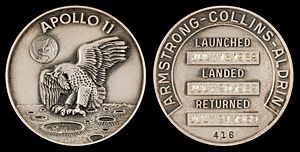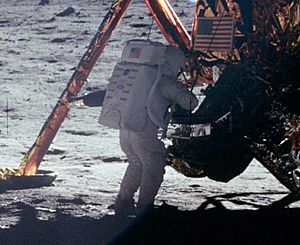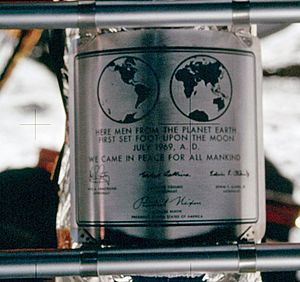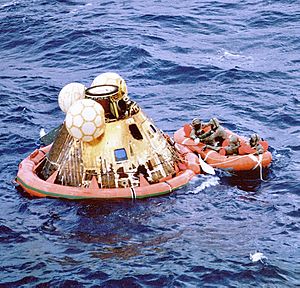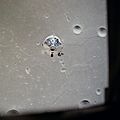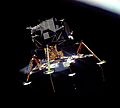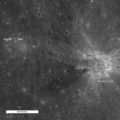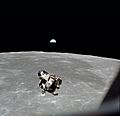Apollo 11 facts for kids
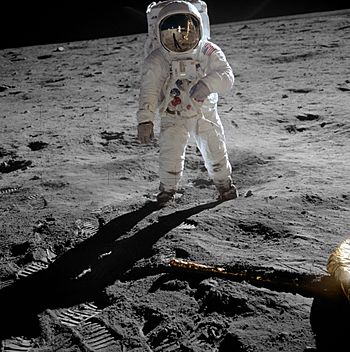
Buzz Aldrin poses on the Moon, allowing Neil Armstrong to photograph both of them using the visor's reflection.
|
|
| Mission type | Crewed lunar landing |
|---|---|
| Operator | NASA |
| Mission duration | 8 days, 3 hours, 18 minutes, 35 seconds |
| Spacecraft properties | |
| Spacecraft |
|
| Lunar orbiter | |
| Spacecraft component | Command and service module |
| Orbital insertion | July 19, 1969, 17:21:50 UTC |
| Orbital departure | July 22, 1969, 04:55:42 UTC |
| Orbits | 30 |
| Crew | |
| Crew size | 3 |
| Members | |
| Callsign |
|
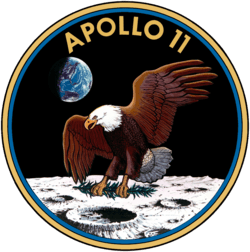 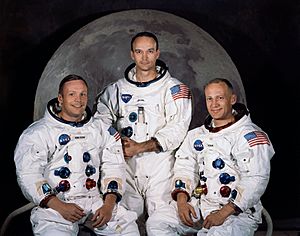 Left to right: Neil Armstrong, Michael Collins, Buzz Aldrin |
|
Apollo 11 was a very important space mission. It was the first time humans landed on the Moon. NASA, the American space agency, launched this mission.
The mission began on July 16, 1969. Three astronauts were on board: Neil Armstrong, Buzz Aldrin, and Michael Collins. On July 20, 1969, Armstrong and Aldrin became the first people to walk on the Moon. Michael Collins stayed in orbit around the Moon in the command module.
This flight was a big part of the Space Race. It completed a goal set by President John F. Kennedy in 1961. He wanted to "land a man on the moon, and return him safely to the Earth" before the 1960s ended.
Contents
Getting Ready for Apollo 11
Mission Patch Design
The mission emblem for Apollo 11 was designed by Michael Collins. He wanted it to show a "peaceful lunar landing by the United States." He chose the bald eagle, America's national bird, as the main symbol.
A simulator instructor suggested adding an olive branch in the eagle's beak. This would show that their mission was peaceful. Collins then added the Moon in the background with Earth far away. The astronauts decided the eagle and Moon would be in their natural colors. They chose a blue and gold border.
Neil Armstrong was worried that people who didn't speak English might not understand "eleven." So, they used "Apollo 11" instead. They also decided not to put their names on the patch. They wanted it to represent everyone who helped make the Moon landing happen.
An artist at the Manned Spacecraft Center (MSC) drew the design. But NASA officials rejected it at first. Bob Gilruth, the MSC director, thought the eagle's claws looked "too warlike." After some talk, the olive branch was moved to the eagle's claws. This patch design was later used on the back of the Eisenhower dollar coin in 1971. It was also used on the smaller Susan B. Anthony dollar in 1979.
Spacecraft Names

The Lunar Module was named Eagle. This name came from the eagle on the mission patch. The command module was named Columbia. This name was inspired by a giant cannon in Jules Verne's 1865 book From the Earth to the Moon. That cannon also launched a spacecraft from Florida. The name Columbia also refers to a historic name for the United States. Michael Collins later said Columbia was named after Christopher Columbus.
Special Items Carried
The astronauts had small bags called personal preference kits (PPKs). These bags held personal items they wanted to take into space. Five PPKs were carried on Apollo 11. Three were on Columbia (one for each astronaut), and two were on Eagle.
Neil Armstrong's PPK for the Lunar Module held some very special items. It had a piece of wood from the Wright brothers' 1903 Wright Flyer airplane. It also had a piece of fabric from its wing. Plus, it carried a diamond-studded astronaut pin. This pin was meant for Deke Slayton from the widows of the Apollo 1 crew. Armstrong took it with him on Apollo 11.
The Journey to the Moon
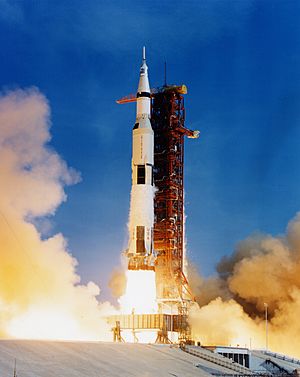
Apollo 11 was launched by a huge Saturn V rocket. It lifted off from Kennedy Space Center in Florida on July 16, 1969, at 1:32 PM UTC. This was the fifth mission in NASA's Apollo program that carried people.
The Apollo spacecraft had three main parts:
- A command module (CM) where the three astronauts lived. This was the only part that returned to Earth.
- A service module (SM) that helped the command module. It provided power, oxygen, water, and helped with movement.
- A lunar module (LM) with two parts. One part was for landing on the Moon, and the other part was for taking the astronauts back into lunar orbit.
After the Saturn V rocket sent them towards the Moon, the astronauts separated their spacecraft. They traveled for three days until they reached the Moon's orbit. Armstrong and Aldrin then moved into the Eagle. They landed in an area called the Sea of Tranquility on July 20.
During the landing, the computer had some problems. Armstrong had to fly the Eagle himself to land it safely. They landed with only 25 seconds of fuel left!
The astronauts used Eagle's top part to lift off from the Moon. They rejoined Collins in the command module. They left Eagle behind before heading back to Earth. They returned to Earth and landed in the Pacific Ocean on July 24. The whole mission lasted more than eight days.
Exploring the Moon
Neil Armstrong and Buzz Aldrin began getting ready to walk on the Moon at 11:43 PM UTC. This took longer than expected, about three and a half hours instead of two. During training on Earth, everything was neatly organized. But on the Moon, the cabin was full of checklists, food, and tools.
Six hours and thirty-nine minutes after landing, Armstrong and Aldrin were ready to go outside. The Eagle was depressurized, meaning the air was let out.
The Eagle's hatch opened at 2:39:33 AM. Armstrong had some trouble getting through the hatch with his portable life support system (PLSS) backpack. Astronauts' heart rates were very high during this part. At 2:51 AM, Armstrong began his climb down to the Moon's surface.
Apollo 11 used a special TV system that was not like regular broadcast TV. So, the signal was shown on a special monitor. A regular TV camera then filmed this monitor. This made the picture quality lower. The signal was first received in the United States. But it was clearer at a station in Australia. Later, a bigger radio telescope in Australia took over the feed.
Even with some problems, black and white images of the first Moonwalk were seen by at least 600 million people on Earth. Copies of this video are still available. However, the original recordings from the Moon were likely erased by NASA.
Armstrong described the Moon dust as "very fine-grained" and "almost like a powder." At 2:56:15 AM, six and a half hours after landing, Armstrong stepped off Eagle's landing pad. He famously said: "That's one small step for [a] man, one giant leap for mankind."
About seven minutes after stepping onto the Moon, Armstrong collected a small soil sample. He put it in a bag on a stick and tucked it into his pocket. This was to make sure they brought back some Moon soil. This was in case they had to leave quickly. Twelve minutes later, he set up the TV camera on a tripod. He took a wide view of the area.
Aldrin joined Armstrong on the surface. He described the view simply: "Magnificent desolation."
Armstrong said moving in the Moon's gravity was easy. The Moon's gravity is one-sixth of Earth's. Aldrin tried different ways to move, including kangaroo hops. The PLSS backpack made them lean backward a bit. But neither astronaut had trouble keeping balance. Loping (a long, easy stride) became the best way to move. The astronauts said they had to plan their steps ahead. The fine soil was quite slippery. Aldrin noticed that moving from sunlight into Eagle's shadow did not change the temperature inside his suit. But his helmet felt warmer in sunlight.

The astronauts put up a United States flag on the Moon. It was clearly visible on TV. Aldrin said raising the flag was one of the most important jobs. But they struggled to push the pole into the hard Moon surface. It only went in about 5 cm (2 inches). Aldrin was worried it might fall over on TV. But he gave "a crisp West Point salute."
Before Aldrin could take a photo of Armstrong with the flag, President Richard Nixon called them. Nixon called it "the most historic phone call ever made from the White House."
Nixon: Hello, Neil and Buzz. I'm talking to you by telephone from the Oval Room at the White House. And this certainly has to be the most historic telephone call ever made from the White House. I just can't tell you how proud we all are of what you have done. For every American, this has to be the proudest day of our lives. And for people all over the world, I am sure that they too join with Americans in recognizing what an immense feat this is. Because of what you have done, the heavens have become a part of man's world. And as you talk to us from the Sea of Tranquility, it inspires us to redouble our efforts to bring peace and tranquility to Earth. For one priceless moment in the whole history of man, all the people on this Earth are truly one: one in their pride in what you have done, and one in our prayers that you will return safely to Earth.
Armstrong: Thank you, Mr. President. It's a great honor and privilege for us to be here, representing not only the United States, but men of peace of all nations, and with interest and a curiosity, and men with a vision for the future. It's an honor for us to be able to participate here today.
They set up the EASEP. This included a device to measure moonquakes. It also had a reflector for a laser experiment. Armstrong then walked about 60 meters (196 feet) from the Lunar Module. He took photos at the edge of Little West Crater. Aldrin collected two core samples. He used a geologist's hammer to push the tubes into the ground. This was the only time the hammer was used on Apollo 11. But he could only go about 15 cm (6 inches) deep.
The astronauts then collected rock samples using scoops and tongs. Many activities took longer than planned. So, they had to stop collecting samples early. Aldrin put 6 kg (13 lbs) of soil into the rock box to pack them tightly. They found two types of rocks: basalt and breccia. Three new minerals were found in these rocks: armalcolite, tranquillityite, and pyroxferroite. Armalcolite was named after Armstrong, Aldrin, and Collins. All these minerals have since been found on Earth.
While on the Moon, Armstrong uncovered a plaque on the Lunar Module ladder. It had two drawings of Earth and a message. It also had the signatures of the astronauts and President Nixon. The message said:
Here men from the planet Earth first set foot upon the Moon July 1969, A. D. We came in peace for all mankind.
The "A.D." stands for Anno Domini ("in the year of our Lord"). This was added at the request of the Nixon administration.
Leaving the Moon and Returning Home
After their work, Armstrong and Aldrin went back into the Eagle. They rested for seven hours before getting ready to leave. While preparing, Aldrin accidentally broke a switch for the engine starter. Armstrong used a pen to fix the circuit. This stopped them from being stuck on the Moon.
Aldrin and Armstrong left many things on the Moon. These included an American flag, some experiments, a golden feather, a logo from Apollo 1, and bronze coins honoring Yuri Gagarin and Vladimir Komarov. They also left a sign with a message from humanity. The sign reads:
Here men from the planet Earth first set foot upon the Moon, July 1969 A.D. We came in peace for all mankind.
On July 24, the three astronauts returned to Earth. They were immediately put into quarantine (kept away from other people). This was to make sure they didn't bring back any unknown diseases from the Moon. They stayed in quarantine for three weeks.
When they came out, they were heroes around the world. They had dinner with President Nixon. They had parades in New York City and Chicago. The three astronauts also appeared on many television shows.
50th Anniversary Celebrations
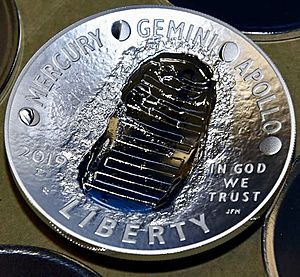
In 2015, a plan was started to create special coins for the 50th anniversary of Apollo 11. These coins would be made of gold, silver, and other metals. On January 24, 2019, the United States Mint released these commemorative coins to the public.
A documentary film called Apollo 11 was released in 2019. It showed restored footage from the 1969 event. It first played in IMAX theaters on March 1, 2019.
Starting July 9, 2019, PBS aired a six-hour documentary series. It was called Chasing the Moon. It looked at the events leading up to Apollo 11. A book with the same name was also released.
Why Apollo 11 Was So Important
When humans walked on the Moon and returned safely, it achieved President Kennedy's goal. This goal was set eight years earlier. In Mission Control during the landing, Kennedy's speech appeared on screen. Then, the words "TASK ACCOMPLISHED, July 1969" flashed.
The success of Apollo 11 showed that the United States had amazing technology. With this success, America won the Space Race.
New sayings became popular in English. "If they can send a man to the Moon, why can't they...?" became a common phrase after Apollo 11. Armstrong's famous words on the Moon also led to many jokes and parodies.
Apollo 11 Spacecraft Today
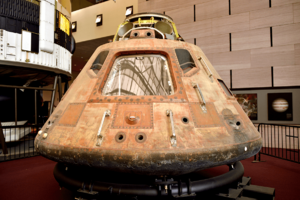
The command module Columbia went on a tour across the United States. It visited 49 state capitals and other places. In 1971, it was given to the Smithsonian Institution. It was displayed at the National Air and Space Museum (NASM) in Washington, DC. It was in the main hall with other famous flight vehicles. These included the Wright Flyer and Spirit of St. Louis.
In 2017, Columbia was moved to prepare for a four-city tour. This tour was called Destination Moon: The Apollo 11 Mission. It visited places like Space Center Houston and the Museum of Flight in Seattle. Later, it was moved to the Cincinnati Museum Center.
For 40 years, Armstrong's and Aldrin's space suits were displayed at the museum. A special display of Armstrong's suit was shown for the 50th anniversary in July 2019. The quarantine trailer and other items are also on display at a Smithsonian annex.
The lower part of the Lunar Module Eagle is still on the Moon. In 2009, the Lunar Reconnaissance Orbiter (LRO) took pictures of the Apollo landing sites. For the first time, these pictures were clear enough to see the lunar module parts. They could even see the astronauts' foot trails. The upper part of Eagle is at an unknown location on the Moon. It was left behind and crashed onto the surface.
In 2012, a team funded by Amazon founder Jeff Bezos found the F-1 engines. These engines were from the rocket stage that launched Apollo 11. They were found on the bottom of the Atlantic Ocean using special sonar. His team brought parts of two of the five engines to the surface. In 2013, a serial number on one engine confirmed it was from Apollo 11. The third stage of the rocket that sent Apollo 11 to the Moon is still orbiting the Sun near Earth.
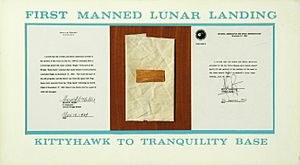
Moon Rocks from Apollo 11
The main place where Apollo Moon rocks are kept is the Lunar Sample Laboratory Facility. This is at the Johnson Space Center in Houston, Texas. A smaller collection is stored in New Mexico for safety. Most of the rocks are kept in nitrogen gas to protect them from moisture. They are handled very carefully using special tools.
Over 100 research labs around the world study these samples. About 500 samples are sent to scientists each year.
In 1969, President Nixon asked NASA to create about 250 special displays. These displays were for 135 countries, all 50 U.S. states, and the United Nations. Each display included Moon dust from Apollo 11 and flags. The flags, including one from the Soviet Union, had traveled with Apollo 11. The Moon dust particles were tiny, about the size of a grain of rice. They were sealed in a clear button. This button made the dust look bigger. Nixon gave these Apollo 11 Moon rock displays as gifts in 1970.
Interesting Facts About Apollo 11
- Armstrong's Hasselblad camera was thought to be lost or left on the Moon.
- In 2015, after Armstrong passed away, his wife found a white cloth bag in his closet. The bag contained items that should have been left on the Moon. This included the 16mm Data Acquisition Camera used to film the first Moon landing. The camera is now on display at the National Air and Space Museum.
- For Apollo missions, a third group of astronauts was added. This was called the support crew. For Apollo 11, the support crew included Ken Mattingly, Ronald Evans, and Bill Pogue.
- Twenty percent of the world's population watched humans walk on the Moon for the first time.
- The Apollo 11 landing is mentioned in songs like "Armstrong, Aldrin and Collins" by The Byrds. It is also in "Coon on the Moon" by Howlin' Wolf.
- The lower part of the Lunar Module Eagle is still on the Moon. In 2009, the Lunar Reconnaissance Orbiter (LRO) took pictures of the landing sites. These pictures were clear enough to see the lunar module parts and even the astronauts' foot trails.
- Armstrong meant to say "That's one small step for a man." But the word "a" is not clear in the recording. So, it was not reported at first. Armstrong later said he believed he did say "for a man."
See Also
Images for kids
-
President John F. Kennedy speaking at Rice University on September 12, 1962
-
CAPCOM Charles Duke (left), with backup crewmen Jim Lovell and Fred Haise listening in during Apollo 11's descent
-
Saturn V SA-506, the rocket carrying the Apollo 11 spacecraft, moves out of the Vehicle Assembly Building towards Launch Complex 39
-
Eagle in lunar orbit photographed from Columbia
-
A girl holding The Washington Post newspaper stating "'The Eagle Has Landed' – Two Men Walk on the Moon"
-
Saturn V rocket projected onto the Washington Monument during the Apollo 11 50th anniversary show
See also
 In Spanish: Apolo 11 para niños
In Spanish: Apolo 11 para niños


